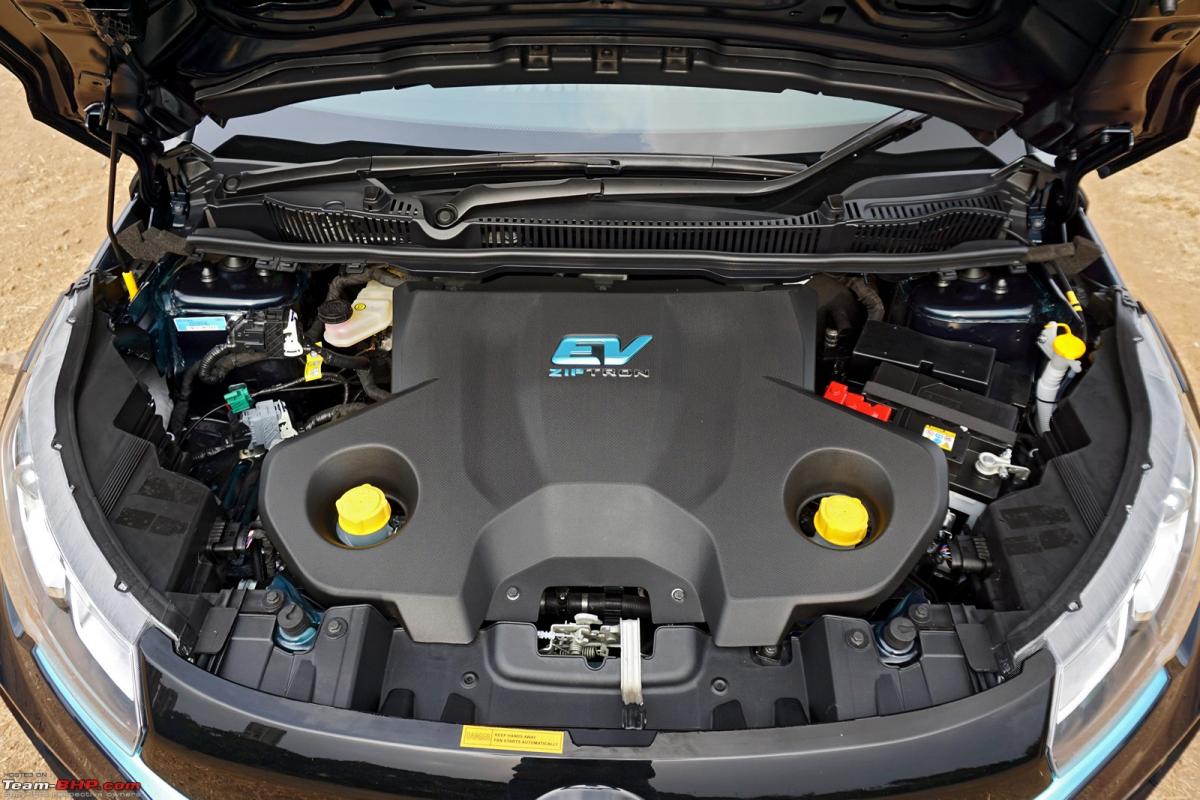2022 Tata Nexon EV Max: Observations after a day of driving
[ad_1]
The Nexon EV Max’s straight-line stability is very good and the car doesn’t feel nervous even when the speedometer crosses 100 km/h. Undulations on the road and bumps do not affect its composure.
Driving the Tata Nexon EV Max
The Permanent Magnet Synchronous Motor puts out 141 BHP & 250 Nm of torque. Compared to the regular Nexon EV, the Max makes 14 BHP and 5 Nm more:

Before we get to the driving part, let’s get the basics right. There are 3 main components in an EV: the battery, the motor and the controller/charger. The battery is what stores the energy and the motor is what uses that energy to move the car. The controller/charger converts the energy from the battery into a usable form to power the motor. In more technical terms, the power grid from your house or a charging station is usually an AC. The lithium-ion battery can store electric energy in DC form. So while charging, there’s usually an AC/DC converter that will convert the power grid’s AC into DC and store it in the car’s battery. The DC fast chargers that you see, usually have the AC/DC converter inbuilt, which is how they can charge the car’s battery faster. The controller typically sits on top of the motor.
Driving an EV is quite a unique experience and recent EVs have all been impressive. Push the engine start button with your foot on the brake pedal and you’ll hear nothing, although the car is “alive” now. There are four transmission modes to choose from: P, D, R and N. Turn the rotary dial to engage D, lift your foot off the brake pedal and the car crawls forward. This will be highly appreciated in heavy traffic conditions where you can drive with just the brake pedal.
Driving in the city is a pleasant experience. The accelerator pedal’s response is linear and not snappy (especially in ‘Eco’ mode). Passengers will appreciate how smooth the drive feels, without any jerks caused by gearshifts or any engine sounds. It is an incredibly refined experience.
Floor the accelerator pedal and you’ll be greeted with instant power / acceleration. This is the beauty of powerful electric motors. The car is quick and has abundant torque right from the get-go. Tata claims a 0-100 km/h time of under 9 seconds (0.9 seconds quicker than the regular Nexon EV) and we believe that. To put that number into perspective, the acceleration is in the vicinity of the Slavia 1.5 TSI & faster than a Honda City. On the move, you will not only be keeping up with traffic, but also overtaking other cars easily. Other road users will be surprised by the pep of this “green number-plate” car :D.
Out on the highway, the Nexon EV Max is fantastic. An advantage of a powerful electric motor is that if you need to perform a quick overtake, there’s no need to wait for a downshift or being in the engine’s powerband. Just bury the accelerator pedal and you’re off! You’ll hit silly speeds with ease and not even realise it due to the lack of drama (engine noise etc.). That being said, single-gear EVs don’t have that higher-end punch that geared turbo-petrol cars do. Keep in mind that if you drive hard, the range drops drastically. This is also why you will see EVs that are driving long distances, stick to the middle lane and cruise at 80-100 km/h (which is the best cruising speed for the current lot of EVs). We already told you that the Nexon EV Max has a realistic range of 300 km. Get aggressive with the A-pedal and you’ll see the range drop significantly. This sensitivity to driving style is more like turbo-petrols rather than turbo-diesels which are so forgiving.
Getting up to cruising speeds is an easy affair and the absence of any sound means you will reach triple-digit speeds without realising it (it’s only when the speed warning chimes sound that you know you’re doing 80 km/h and 120 km/h).
There are 3 driving modes to choose. They’re mapped specifically for different driving styles.
- City Mode: The default mode. The car always restarts in this mode, no matter what mode you last drove in. It’s great for driving in the city as well as on the highway. Strikes a good balance between power and economy.
- Eco Mode: The mode to engage when you want the maximum range. Throttle response is dumbed down, which actually results in a smoother drive in the city (less of that “torque-pull” effect). Power comes in more gradually when you ask for it. While there’s enough grunt for day-to-day driving or cruising on the expressway, when you need to pull off a quick overtaking manoeuvre, you will want to engage one of the other modes.
- Sport Mode: The mode when you really want to have fun. Floor the A-pedal in Sport mode and watch the traction control warning light flash in the instrument cluster. In this mode, throttle response is sharper and the car just feels more eager to get a move on. However, it can feel too peaky for city driving and also eats up the battery faster. Use “Sport” when you’re looking for fun on expressway runs.
Different driving modes are depicted by different colours on the gear selector. Blue for city mode…

…green for Eco mode…

…and red for Sport mode:

Regenerative Braking
There are 3 levels of regenerative braking – we absolutely love adjustable regen settings as we can tune it to suit our mood. At levels 1 and 2, there’s obviously lesser resistance when you lift off the accelerator pedal. Driving on level 3 enables maximum regeneration. Engine braking lovers will appreciate driving with regen at the maximum level. You can also do one-pedal driving in many situations. Unlike the MG ZS EV that we drove earlier this year, the regen function can be switched off as well. This allows the car to coast without any resistance.
Noise, Vibration & Harshness (NVH)
There is no engine noise at all. The only sound coming is a faint whine from the electric motor at high revs. With no gearshifts & minimal mechanical parts, there are no jerks or vibrations. On the highway, tyre noise starts creeping into the cabin at 80 km/h. You’ll hear it more because there is no engine sound to drown some of it out. Around 90 km/h, we could hear some wind noise as well. Again, more noticeable because there is no engine sound.
Range
Tata claims a range of 437 km with the new 40.5 kWh battery pack. However, these numbers are very subjective and the real-life range solely depends on how you drive the car. 300 km should be doable IMHO. Can go lower or higher, depending on how you use the accelerator. We await real-life reports from BHPian owners of this car.
Charging
The Nexon EV Max gets the industry-standard CCS 2 charging port. A 7.2 kW home charger which can be installed at your home or office, can charge the 40.5 kWh battery pack from 0-100% in 6.5 hours. If you’re travelling somewhere, you can use the portable charger in the boot to charge the car from any 15 Amp socket (the larger 3-pin sockets used for ACs and fridges), which would take about 15 hours to charge from 10-100%. In comparison, the 30.2 kWh battery of the regular Nexon EV takes 10 hours to charge with a 3.3 kW AC charger. Do note that in all EVs, the initial 0 – 80% charging happens quicker…the final 81 – 100% takes more time. The last option is the 50 kW DC fast chargers that you will find at some of the charging stations. This would fill up your car’s battery from 0-80% in 56 minutes. GTO thinks a 15A charger is all that 99% of owners will need – his article on the same.
Tata Motors has been working with its sister company, Tata Power, to improve the charging infrastructure. The Tata Power EZ Charge app helps you locate nearby charging stations and book a slot.
Besides, there are plenty of charging stations popping up everywhere, which ought to reduce range anxiety. There are many apps and websites like pulseenergy.io, plugshare.com, etc. that list out all the charging stations near you. End of the day though, remember the golden rule = EVs are best charged where they are parked (either at your office or home).
The charging sockets are placed under the fuel flap:

Socket for the regular charger on the top and one for the fast charger below:

The 15A charger that you get with the car takes ~15 hours to charge the batteries from 10-100%. Best to charge it overnight (at home) or when parked at the office (during the day):

7.2 kW AC fast charger can charge the battery pack from 0-100% in 6.5 hours. It comes with an RFID card for quick charging authorisation and LED illumination:

To charge the Nexon EV Max, you’ll have to install the Tata EZ Charge app. The app displays all the charging stations close to you. When you tap on a particular station, it will show the type of charging ports available at the station. Once you have selected the station, you can choose the type of charging – amount, units of charge, time for a charge & percentage of the charge. The app will then show the amount you have to pay. You can plug in the charger and wait. The overall process is quite easy and even a first-time user won’t have any issues navigating through the app:

Suspension

Ride Comfort
The car gets a MacPherson strut suspension at the front and a twist-beam with dual path strut suspension at the rear. It rides on 16″ alloy wheels that are shod with 215/60 section tyres. The recommended tyre pressure is 34 PSI. Like most fossil-fuel cars converted to electric, the Nexon EV Max’s suspension has been stiffened up to cope with the 100 kilos of extra weight due to the heavy battery pack and other equipment.
At low speeds, the ride is firm, but not harsh. Smaller bumps are not felt, but the larger ones and deeper potholes do make their presence felt in the cabin. As speeds increase, the ride improves significantly. Overall, we will say that the ride of the Nexon EV Max is compliant, but not plush.
Handling & Dynamics
The Nexon EV Max’s straight-line stability is very good and the car doesn’t feel nervous even when the speedometer crosses 100 km/h. Undulations on the road and bumps do not affect its composure. The stiffer suspension and 50:50 weight distribution have endowed the car with good handling characteristics. Its center of gravity is low and body roll is well controlled. The grip from the MRF Wanderers is more than adequate and the car holds its line well when hustled through a series of fast corners.
Steering
The electric power steering is one of the nicer units around. It is light at city speeds and weighs up sufficiently as the speed increases. The EPS isn’t lifeless and does give you some feel of what the front wheels are up to. At higher speeds, it inspires confidence.
Braking
While the Nexon EV comes with disc brakes at the front and drums at the rear, the Nexon EV Max gets an all-wheel disc brake setup. This provides excellent stopping power. Emergency braking situations are handled well and the car is brought to a halt from high speeds effectively. Besides, the car is equipped with ABS + EBD, corner stability control, disc brake wiping, hydraulic fading compensation, panic brake alert and after-impact braking.
[ad_2]
Source link










